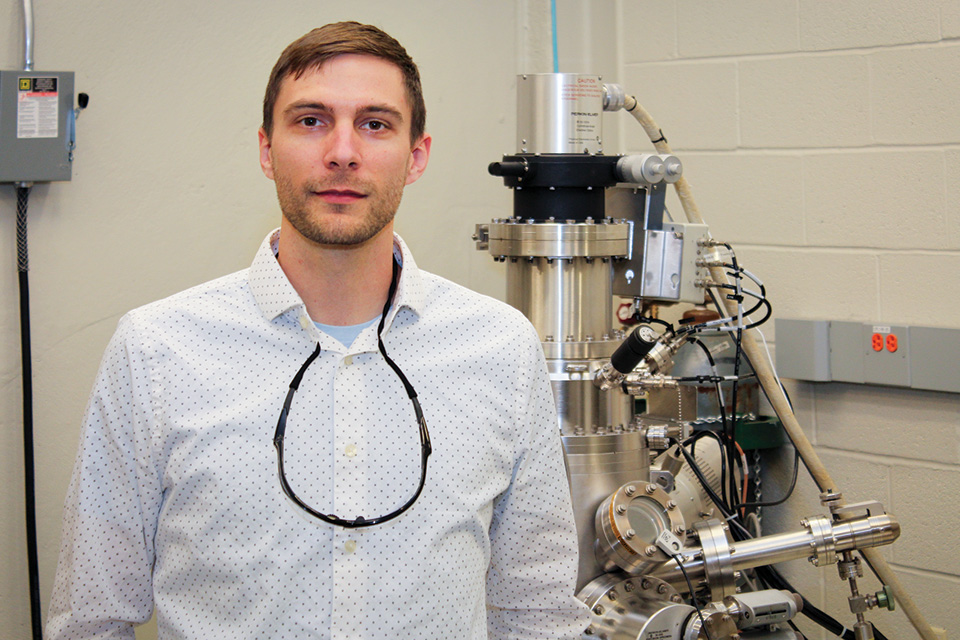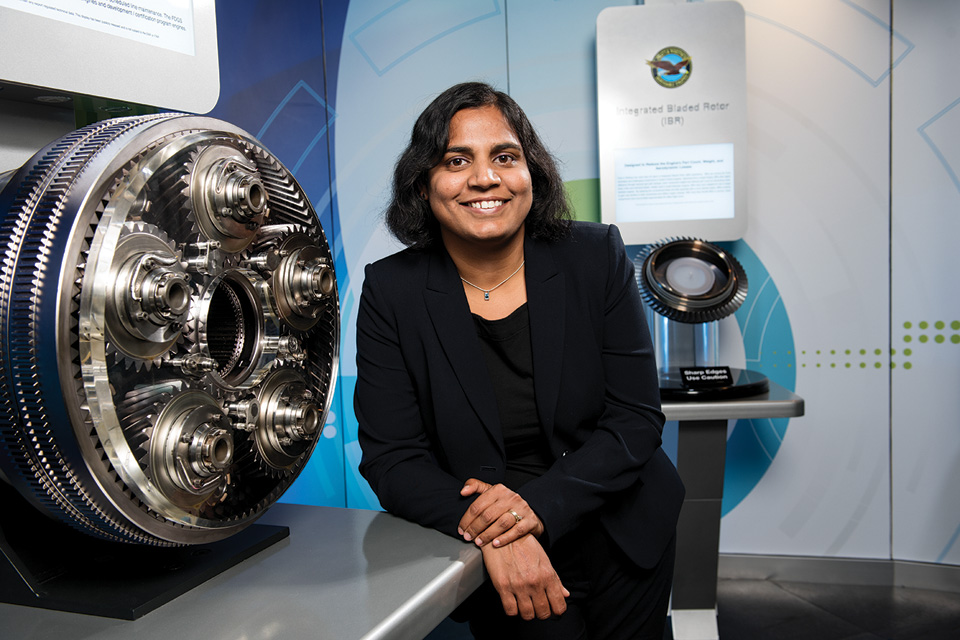December 8, 2016
Fascinated by the potential to help create new discoveries from materials, Nonso Chetuya ('16) knew he wanted to be a materials scientist at 15.

Nonso Chetuya ('16) (Photo by Michael Clements)
"The ability to change materials using science is a wonder to me," says Chetuya, a quality assurance engineer at Lockheed Martin in Grand Prairie. "Modern-day materials science is like real alchemy, changing materials to better the world."
Alumni like Chetuya -- from UNT's materials science department in the College of Engineering, one of the university's fastest growing areas -- are working at leading aerospace, defense and technology industries to create the future innovations of the 21st century. They are not only investigating new sustainable materials, but also helping to gain a better understanding of the limitations and possibilities of current materials used in manufacturing.
Many of them got their start as students working side by side with experts in UNT's program, ranked a Top 100 in the nation by U.S. News & World Report. One of those experts is Rajiv Mishra, a Distinguished Research Professor of materials science and engineering who has led the Center for Friction Stir Processing, an Industry/University Cooperative Research Center site at UNT, for 10 years. The center, in collaboration with three other universities, garners funding from the National Science Foundation, Office of Naval Research and Defense Advanced Research Projects Agency. And UNT's Advanced Materials and Manufacturing Processes Institute (AMMPI), also led by Mishra, is one of UNT's four Institutes of Research Excellence. It brings together faculty working to design high-performance materials for industry.
"AMMPI is the perfect example of what UNT is doing to take our research to the next level," says Costas Tsatsoulis, dean of the College of Engineering. "This institute is made up of researchers from a wide variety of fields and they are all collaborating to develop new materials that can make our everyday lives better."
State-of-the-art defense
Chetuya says that he chose UNT for the opportunity to take part in the materials science research he always dreamed of doing.
"UNT was publishing a lot of articles. I saw the research the faculty was doing," he says. "It seemed like the best place to be to help change the world."
As soon as Chetuya arrived on campus, he roamed the halls of Discovery Park checking out labs. He also asked a lot of questions that led to Witold Brostow, professor of materials science, asking him to help with research. Soon he was participating in senior-level lab work as a freshman, which caught the attention of recruiters and resulted in five job offers his senior year.
He accepted a position with Lockheed Martin, working on making high-precision, high-altitude missiles for the military.
"We are looking to see if there are any parts of the missile that could jeopardize the mission, and we make a failure analysis," he says. "And then we figure out how to make it work better.
"UNT helped me to learn to ask the right questions. I've only been here five months and they already call me the subject materials expert."
Saving lives

Jon-Erik Mogonye ('10, '12 M.S., '16 Ph.D.) (Photo by Adrian Hood)
Unlike Chetuya, Jon-Erik Mogonye ('10, '12 M.S., '16 Ph.D.) didn't know as a student in 2005 that he wanted to study materials science. He came to UNT intending to major in sculpture, but he couldn't deny his love for science.
"Realizing that I was meant for engineering was a revelation, not a designed choice," he says.
He earned his bachelor's degree in mechanical engineering, but a research opportunity as an undergraduate working as a microscopist focused his interest on materials science. The student position gave him the chance to use state-of-the-art electron and ion microscopes in UNT's Center for Advanced Research and Technology (CART).
After Mogonye graduated, Thomas Scharf, professor of materials science, encouraged him to work on his master's degree and offered him a chance to work in his lab.
He then helped him land an internship with Sandia National Laboratory while he worked on his Ph.D. At Sandia, Mogonye was part of a group of researchers awarded a patent in 2015 titled "Ion Beam Modification of Noble Metals for Electrical Contacts."
"In this field you have the opportunity to be creative and design as an engineer on a microscopic level," he says.
Now, Mogonye is a postdoctoral research fellow at the Army Research Laboratory in Adelphi, Md., designing and testing new materials to make helicopters safer for servicemen and women.
"Success always comes down to the people who help you. And the engineering faculty at UNT are very strong," Mogonye says. "It's their ability to teach, but also the help they give outside of the classroom. They lead you to connections and help you figure out the next step after university."
Secure computers

Hari Mallela (Courtesy of IBM)
Hari Mallela came to UNT in 1989 to complete a postdoctoral fellowship in materials science after earning a Ph.D. in physics from Delhi University. He was looking for a teaching assignment in the U.S. when he met William Deering, a former physics professor at UNT, who told him about the opening at UNT.
"My time at UNT is when I really discovered my passion," Mallela says. "It's when I went from theory to hands on. I realized I could help make companies work better by creating better materials."
After his time at UNT, Mallela worked for Teccor Electronics and Texas Instruments and as a consultant. He then took a job as a senior scientist at IBM in New York, where he is now making the next generation of computers safer and smarter.
"There is a potential for security breaches with existing computers," he says."We are working to build a next-generation computer that is secure and will be able to address complicated computations."
He's also hoping to advance artificial intelligence in computers to do everything from helping businesses realize when they need to restock shelves to making smarter toys and solving medical problems.
"This work will help to take everything we know about diseases and have computers digest all the information to provide summaries and hopefully answers," he says.
Knowing how to work on a team of researchers is one of the best lessons Mallela says he learned at UNT.
"In research and in industry, you have to work with people," he says. "You can't do it all by yourself."
Safer airplanes

Haritha Namduri ('03 M.S., '07 Ph.D.) (Courtesy of Spencer Sloan/Pratt & Whitney)
Haritha Namduri ('03 M.S., '07 Ph.D.) also understands the importance of working on a team. As a failure analysis engineer at Pratt & Whitney, an aerospace company in East Hartford, Conn., she works with a group to make sure commercial and military aircraft engines are safe.
"If there is an airplane incident that is P&W engine-related, we investigate," she says. "We also work to find the cause of any problems with any new materials before those materials ever go into the field."
Namduri says one of her favorite parts of working as a materials engineer is the opportunity to problem solve and adapt.
"No matter how good your design is, you are limited by the quality and capability of materials," Namduri says, adding that this motivates her. "So, by creating better materials we can help make better designs."
Namduri first came to UNT to get her master's degree in mechanical engineering technology and fell in love with the research process, so she continued on to earn a doctoral degree in materials science.
"I loved my research and the faculty, especially Seifollah Nasrazadani and Leticia Anaya," she says, adding that they encouraged her to do research in their labs.
"I would just hang out and work on experiments," she says. "When it comes to UNT, it's really all about the professors."